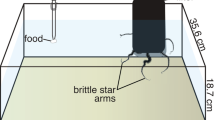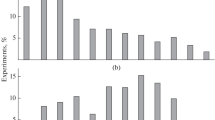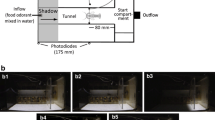Abstract
Because most learning studies in cephalopods have been performed on octopods, it remains unclear whether such abilities are specific to octopus, or whether they correlate with having a larger and more centrally organized brain. To investigate associative learning in a different cephalopod, six sexually mature cuttlefish (Sepia officinalis) participated in a counterbalanced, within-subjects, appetitive, classical conditioning procedure. Two plastic spheres (conditioned stimuli, CSs), differing in brightness, were presented sequentially. Presentation of the CS+ was followed 5 s later by a live feeder fish (unconditioned stimulus, US). Cuttlefish began to attack the CS+ with the same type of food-acquisition seizures used to capture the feeder fish. After seven blocks of training (42 presentations of each CS) the difference in seizure probability between CS+ and CS− trials more than doubled; and was found to be significantly higher in late versus early blocks. These results indicate that cuttlefish exhibit autoshaping under some conditions. The possible ecological significance of this type of learning is briefly discussed.

Similar content being viewed by others
References
Boal J (1996a) A review of simultaneous visual discrimination as a method of training octopuses. Biol Rev 71:157–190
Boal J (1996b) Absence of social recognition in laboratory-reared cuttlefish (Sepia officinalis) L. (Mollusca: Cephalopoda). Anim Behav 52:529–537
Boal J, Wittenberg K, Hanlon R (2000) Observational learning does not explain improvement in predation tactics by cuttlefish (Mollusca: Cephalopoda). Behav Process 52:141–153
Brown P, Jenkins H (1968) Auto-shaping the pigeon’s key peck. J Exp Anal Behav 11:1–8
Budelmann B (1995) The cephalopod nervous system: what evolution has made of the molluscan design. In: Breidbach O, Kutsch W (eds) The nervous system of invertebrates: an evolutionary and comparative approach. Birkhäuser Verlag, Basel, pp 115–136
Dickel L, Boal J, Budelmann B (2000) The effect of early experience on learning and memory in cuttlefish. Dev Psychobiol 36:101–110
Fiorito G, Scotto P (1992) Observational learning in Octopus vulgaris. Science 256:545–547
Hearst E, Jenkins HM (1974) Sign-tracking: the stimulus-reinforcer relation and directed action. Psychonomic Society, Austin
Karson M, Boal J, Hanlon R (2003) Experimental evidence for spatial learning in cuttlefish (Sepia officinalis). J Comp Psychol 117:149–155
Mather J (1995) Cognition in cephalopods. Adv Study Behav 24:317–353
Messenger J (1968) The visual attack of the cuttlefish, Sepia officinalis. Anim Behav 16:342–357
Messenger J (1973) Learning in the cuttlefish, Sepia. Anim Behav 21:801–826
Moore BR (2004) The evolution of learning. Biol Rev 79:301–335
Purdy J, Roberts A, Garcia C (1999) Sign tracking in cuttlefish (Sepia officinalis). J Comp Psychol 113:443–449
Teichert C (1988) Main features of cephalopod evolution. In: Clark M, Trueman E (eds) The Mollusca: paleontology and neonatology of cephalopods. Academic, San Diego, pp 215–288
Terrace H, Gibbon J, Farrell L, Baldock M (1975) Temporal factors influencing the acquisition of an autoshaped keypeck. Anim Learn Behav 3:53–62
Tomie A, Brooks W, Zito B (1989) Sign-tracking: the search for reward. In: Klein S, Mowrer R (eds) Contemporary learning theories: Pavlovian conditioning and the status of traditional learning theory. Erlbaum, Hillsdale, pp 191–223
Acknowledgements
This research was funded by a grant from the Natural Sciences and Engineering Research Council of Canada (NSERC) to S.A. Adamo. This study was approved by the Dalhousie University Animal Care Committee.
Author information
Authors and Affiliations
Corresponding author
Supplementary video material
S1 This video shows a CS- trial followed by a CS+ trial from block 7 for Cuttlefish #7. 7 During the CS- trial the cuttlefish initially moves away, eventually orients to, but does 8 not approach the CS. During the CS+ trial, the cuttlefish’s first strike is directed towards 9 the CS, and the second strike captures the fish (US).
mpg (30 MB)
Rights and permissions
About this article
Cite this article
Cole, P.D., Adamo, S.A. Cuttlefish (Sepia officinalis: Cephalopoda) hunting behavior and associative learning. Anim Cogn 8, 27–30 (2005). https://doi.org/10.1007/s10071-004-0228-9
Received:
Accepted:
Published:
Issue Date:
DOI: https://doi.org/10.1007/s10071-004-0228-9




